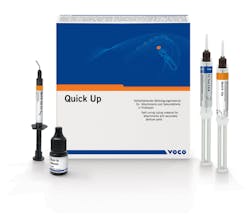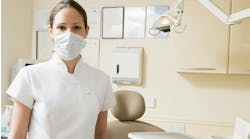Attachments are one of the best advances in removable prosthodontics, but the conventional method of using acrylic repair resin for attachment processing can be a challenge. Fortunately, a self-curing luting material offers a solution.
Attachments are one of the best advances in removable prosthodontic dentistry. We use them for overdentures with retained roots, with implants, and with partial dentures and fixed bridgework. Locator attachments and ERA attachments are among these, and there are many additional attachment systems.
What all attachment systems share is that the attachments need to be processed to the acrylic denture base. The lab can do it from a cast, but I prefer to do it chairside after verifying the fit of the intaglio surface to the residual ridges. Conventionally, we've used polymethylmethacrylate (PMMA), our straight-up acrylic repair resin, with the Nealon technique of powder-liquid dipping the brush and applying the drop of acrylic to the attachment.
With this method, you need a good hand technique so you don't get extra acrylic flowing where you don't want it to go. There's also the concern of the 10-minute setting time. Ifthe acrylic doesn’t set completely because it has somehow become contaminated, you have to start all over again. And for patients with chemical sensitivities, there's the acrylic smell . . .
Here are the significant advantages of using Quick Up: It comes in an automix syringe (no dappen dishes or brushes); it has no odor; it takes three minutes to set; and it comes with a light-cure resin syringe that can be used to fill any voids directly.
The technique involves applying a primer to the clean denture surface and letting it air-dry for one minute. The Quick Up is then syringed into the attachment reservoir in the denture, the denture is seated, and three minutes later, a secure attachment is processed.
I have also used this material to reattach a denture tooth (primer was applied to both the tooth and the denture base), to repair a crack in a denture base, and to fill in a space adjacent to a natural tooth.
Give this material a try because—I suspect—you will really enjoy using it like I do.
Editor's Note: This article first appeared in Pearls for Your Practice: The Product Navigator.Click here to subscribe. Click here to submit a products article for consideration.








